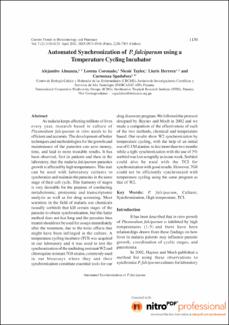Mostrar el registro sencillo del ítem
Automated Synchronization of P. falciparum using a Temperature Cycling Incubator
| dc.contributor.author | Almanza, Alejandro | |
| dc.contributor.author | Coronado, Lorena | |
| dc.contributor.author | Tayler, Nicole | |
| dc.contributor.author | Herrera, Liuris | |
| dc.contributor.author | Spadafora, Carmenza | |
| dc.date.accessioned | 2020-06-04T21:03:12Z | |
| dc.date.available | 2020-06-04T21:03:12Z | |
| dc.date.issued | 2011-04 | |
| dc.identifier.issn | https://www.abap.co.in/automated-synchronization-p-falciparum-using-temperature-cycling-incubator | |
| dc.identifier.uri | http://repositorio-indicasat.org.pa/handle/123456789/44 | |
| dc.description | As malaria keeps affecting millions of lives every year, research based in culture of Plasmodium falciparum in vitro needs to be efficient and accurate. The development of better techniques and methodologies for the growth and maintenance of the parasites can save money, time, and lead to more trustable results. It has been observed, first in patients and then in the laboratory, that the malaria falciparum parasites growth is affected by high temperatures. This trait can be used with laboratory cultures to synchronize and maintain the parasites in the same stage of their cell cycle. This harmony of stages is very desirable for the purpose of conducting metabolomic, proteomic and transcriptome analysis as well as for drug screening. Most scientists in the field of malaria use chemicals (usually sorbitol) that kill certain stages of the parasite to obtain synchronization, but this latter method does not last long and the parasites thus treated should not be used for assays immediately after the treatment, due to the toxic effects that might have been infringed in the culture. A temperature cycling incubator (TCI) was acquired in our laboratory and it was used to test the synchronization of the multidrug resistant W2 and chloroquine resistant 7G8 strains, commonly used in our bioassays where they and their synchronization constitute essential tools for our drug discovery program. We followed the protocol designed by Haynes and Moch in 2002 and we made a comparison of the effectiveness of each of the two methods, chemical and temperature based. Our results show W2 synchronization by temperature cycling, with the help of an initial use of 0.3 M alanine, to last more than two months while a tight synchronization with the use of 5% sorbitol was lost as rapidly as in one week. Sorbitol could also be used with the TCI for synchronization with good results. However, 7G8 could not be efficiently synchronized with temperature cycling using the same program as that of W2. | en_US |
| dc.description.abstract | As malaria keeps affecting millions of lives every year, research based in culture of Plasmodium falciparum in vitro needs to be efficient and accurate. The development of better techniques and methodologies for the growth and maintenance of the parasites can save money, time, and lead to more trustable results. It has been observed, first in patients and then in the laboratory, that the malaria falciparum parasites growth is affected by high temperatures. This trait can be used with laboratory cultures to synchronize and maintain the parasites in the same stage of their cell cycle. This harmony of stages is very desirable for the purpose of conducting metabolomic, proteomic and transcriptome analysis as well as for drug screening. Most scientists in the field of malaria use chemicals (usually sorbitol) that kill certain stages of the parasite to obtain synchronization, but this latter method does not last long and the parasites thus treated should not be used for assays immediately after the treatment, due to the toxic effects that might have been infringed in the culture. A temperature cycling incubator (TCI) was acquired in our laboratory and it was used to test the synchronization of the multidrug resistant W2 and chloroquine resistant 7G8 strains, commonly used in our bioassays where they and their synchronization constitute essential tools for our drug discovery program. We followed the protocol designed by Haynes and Moch in 2002 and we made a comparison of the effectiveness of each of the two methods, chemical and temperature based. Our results show W2 synchronization by temperature cycling, with the help of an initial use of 0.3 M alanine, to last more than two months while a tight synchronization with the use of 5% sorbitol was lost as rapidly as in one week. Sorbitol could also be used with the TCI for synchronization with good results. However, 7G8 could not be efficiently synchronized with temperature cycling using the same program as that of W2. | en_US |
| dc.language.iso | eng | en_US |
| dc.rights | info:eu-repo/semantics/openAccess | |
| dc.rights | https://creativecommons.org/licenses/by-nc-sa/4.0/ | |
| dc.subject | P. falciparum | en_US |
| dc.subject | Culture | en_US |
| dc.subject | Synchronization | en_US |
| dc.subject | High temperature | en_US |
| dc.subject | TCI | en_US |
| dc.title | Automated Synchronization of P. falciparum using a Temperature Cycling Incubator | en_US |
| dc.type | info:eu-repo/semantics/article | en_US |
| dc.type | info:eu-repo/semantics/publishedVersion |

